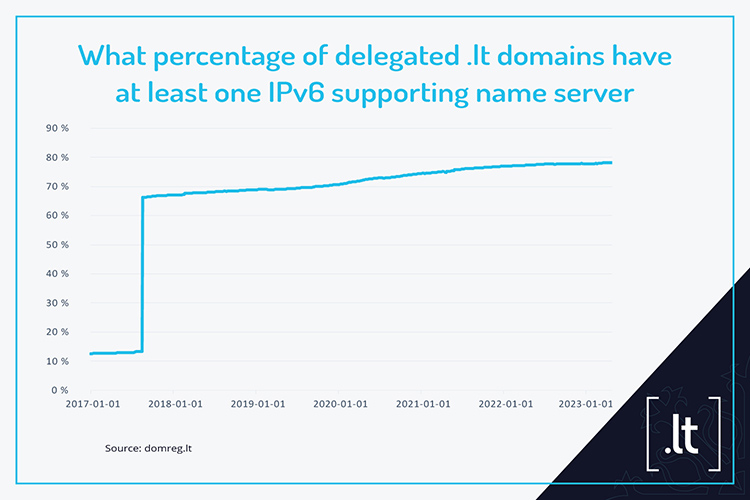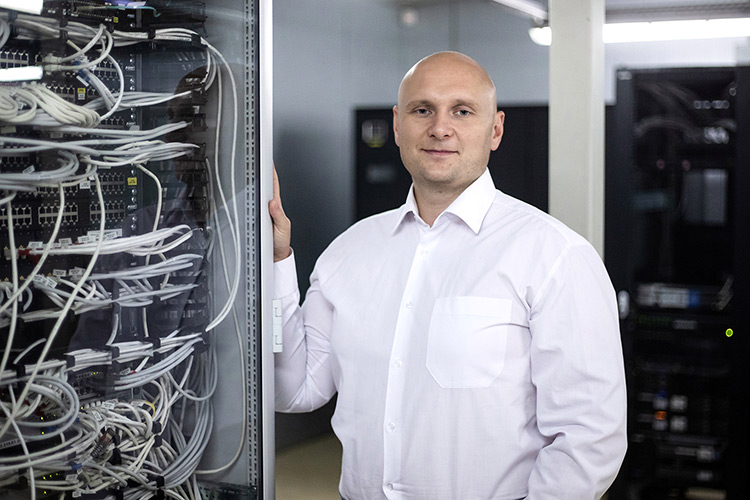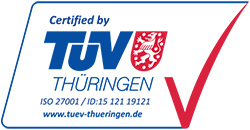Check .lt domain
Can the Lithuanian internet accommodate everyone: when will we stop using IPv4 addresses and connect to the network via IPv6?
The Internet Service Centre DOMREG specialists at Kaunas University of Technology (KTU) conducted the data analysis to find out how well the Lithuanian internet infrastructure is prepared for the next-generation IPv6 protocol. The analysis of Domain Name System (DNS) records of the registered .lt domains indicated that 78.12% of the second-level .lt domains have a name server supporting IPv6, but only 11.10% of websites are accessible using the IPv6 protocol. Only 11.45% of the second level .lt domain mail servers can receive email via IPv6 protocol. A total of 227 982 DNS records of NS, AAAA and MX types for delegated .lt domains were analysed.
Everybody cannot fit online anymore
Tomas Mackus, Head of the KTU Internet Service Centre DOMREG, tells that every device – computer, server, telephone, washing machine, etc. – that connects to the internet must have an Internet Protocol (IP) address, which identifies the device on the network. The IPv4 address is currently the most widely used and consists of four numbers separated by dots; each of these numbers cannot exceed 255 (for example, 192.0.2.28). This allows for approximately 4 billion IPv4 addresses.
“The sixth-generation IPv6 internet protocol was developed at a time when everyone realised that the number of addresses for version 4 was finite and that everyone cannot fit online anymore. The realisation that addresses could run out quickly enough with the growing number of internet users and internet-connected devices in the world led to the development of the next-generation IP protocol. This prediction came true a few years ago when the last of the version 4 IP addresses were distributed to local internet registrars (mostly internet service providers),” – emphasises T. Mackus.

With the Earth’s population is now around 8 billion and people using more than one device connected to the internet, the problem of the shortage of generation 4 addresses has become relevant.
How is IPv6 superior to IPv4?
When comparing IPv6 with the old IPv4, we can notice an increase in the length of the address. The length of an IPv6 address is 128 bits and it is written in pairs of hexadecimal numbers separated by colons (for example, 2001:0db8:85a3:0a32:0b01:8a2e:0370:7334). The shorter 32-bit field for an IPv4 address is usually written in decimal numbers.
According to Tomas Simonaitis, Head of the Technical Administration Office at KTU Internet Service Centre DOMREG, the IPv6 protocol can be used to create a significantly larger number of unique IP addresses – as many as 340 undecillion.
“If the IPv4 protocol only allows to make approximately 4 billion addresses, and the number of people living in the world has long since exceeded this limit, this large increase in the number of addresses that can be created with IPv6 protocol is a major advantage of the functionality of the IPv6 protocol over IPv4. It is also important to keep in mind the flexibility of the network architecture and the dynamic nature of routing,” – assures T. Simonaitis.
IPv6 has been introduced in the .lt domain infrastructure since 2008
The global introduction of IPv6 began in 1995. It was introduced in the top-level .lt domain infrastructure in 2008.
“New descriptions of the internet standards were created about the new version of IP addresses, and we all had to migrate to the new IP protocol little by little. Therefore, to make sure that the domain resolution for the DNS queries received via IPv6 protocol is available and that it does not become a point hindering the use of the protocol, the IPv6 protocol has been introduced in the .lt domain as well,” – recalls T. Mackus, Head of KTU Internet Service Centre DOMREG.
A little later, in 2012, the introduction of the IPv6 protocol was also completed by major technology companies such as Google, Facebook and Microsoft, as well as internet service providers and hardware manufacturers in various countries. However, simultaneous support of IPv4 addresses, which are still in use today, was provided to avoid malfunctions.
IPv6 protocol is supported by 78% of delegated .lt domain name servers
An analysis of the DNS records of registered .lt domain name servers indicated that 78.12% of second-level .lt domains have at least one name server supporting IPv6. 76.01% have at least two name servers supporting IPv6. Until 2017, IPv6 support in name servers was around 12%, but it jumped to 66% later on and has been growing ever since.

“One of the largest and most widely used .lt domain service providers added Cloudflare name servers in 2017, which provide DNS services using both IPv4 and IPv6 protocols. This is why the increase has been noticeable since 2017.
Looking at the statistics on the use of IPv6 in name servers and comparing them with the statistics on the IP addresses held by Lithuanian internet service providers, we see a similar situation – around 80% of them have IPv6 addresses and can distribute them among internet users and other customers who provide various services, including hosting websites.
I would like to say that around 20% of registrars do not even have IPv6 addresses that they could get easily because there is no shortage of them, but apparently they have no plans to provide services using this protocol,” – says T. Mackus.
To help all .lt domain holders use IPv6 protocol in their name servers, the .lt domain registry provides one name server supporting IPv6 free of charge.
“All .lt domain holders could already be using name servers supporting IPv6 protocol. The DNS name server ns2.domreg.lt is available free of charge and this .lt domain registry’s name server supports IPv6. The solution here would be not to add IPv6 to your infrastructure, which is a bit more complicated, but use ns2.domreg.lt instead, as an additional DNS server and allow access to DNS records. Then the domain would be resolved with both protocols”, - assures T. Simonaitis, Head of the Technical Administration Office at KTU Internet Service Centre DOMREG.
Name servers alone are not enough
To use IPv6 protocol, the entire network has to be adapted, from the server that hosts the website’s files and databases to the internet service provider’s network, the DNS root and recursive servers, and the web browser on the user’s computer or telephone.

“Most likely, the user’s computer with a web browser does not resolve the domain name directly but uses the internet service provider’s recursive DNS servers. If the user is only using the IPv6 protocol, the recursive DNS servers must also be accessible via IPv6 protocol.
Further on, the users have to ask whether the servers for websites and email and other services also support IPv6 protocol,” – points out T. Simonaitis.
Most Lithuanian websites are inaccessible via IPv6 protocol
As indicated by the analysis of the DNS records of registered .lt domain name servers, only 11.14% of delegated .lt domains have a server address supporting IPv6 (a DNS record of an AAAA type).
“I think that registrars are probably not very interested, because using IPv6 protocol in addition to IPv4 protocol requires higher costs, both in terms of server administration and security insurance. There is twice as much work, the costs are rising, and so far, there is no need for the IPv6 protocol or a significant problem of a shortage of IPv4 addresses in the European region. Europe still has enough IP addresses of version IPv4 which are shared among local internet registrars. The IPv4 shortage is probably a more acute problem for rapidly developing countries that failed to get IPv4 addresses on time when they were still available,” – explains T. Mackus, Head of KTU Internet Service Centre DOMREG.
Email servers also do not support IPv6
Another very important service, email, is also not provided via IPv6 protocol. Only 11.45% of the second-level .lt domains have an email server supporting IPv6 (a DNS record of an MX type).
“At the moment, it is still a little too bold to have a website or email servers that can only be accessed via IPv6: it is likely that a very large number of people will not be able to connect to such a website or send an email at all, so for the time being, we need websites and email servers that are accessible via both protocols.
Those using only IPv6 addresses are often forced to use NAT64 and similar solutions to access servers that do not use IPv6 addresses.
The idea was to use these technologies for a transitional period, but that transitional period has become longer than anticipated. 15 years ago, it was said that everyone would migrate to IPv6. Now, I do not see any acceleration in the use of IPv6. It is used by those who have it, but I cannot say that we could already stop using IPv4”, - summarises T. Simonaitis, Head of the Technical Administration Office at KTU Internet Service Centre DOMREG.
Lithuania has a sufficient number of IPv4 addresses
According to the data of the Network Coordination Centre RIPE, Lithuanian internet service providers (local internet registrars) manage 2.6 million IPv4 addresses. There is almost one IPv4 address per person in Lithuania. The statistics for IPv4 addresses per capita are very similar in Latvia and Estonia.
In terms of IPv6 usage, according to RIPE, Lithuania is ahead of its nearest neighbours Latvia and Poland. Lithuania has around 28% of its networks published via IPv6 protocol, Latvia has 20% and Poland has 16%. Germany is a leader in the Baltic Sea Region with 57% of its networks published via IPv6 protocol. Sweden has 52%, Finland 46%, Denmark 42% and Estonia 40% of its networks accessible via IPv6.
You can find out the .lt domain accredited registrars that supporting IPv6 protocol here: https://www.domreg.lt/en/registrars/
Published 2023-06-15



